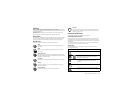
66 Safety, Regulatory & Legal
Navigation
Navigation
If your Motorola mobile device provides navigation features, note that mapping information,
directions, and other navigational data may contain inaccurate or incomplete data. In some
countries, complete information may not be available. Therefore, you should visually confirm
that the navigational instructions are consistent with what you see. All drivers should pay
attention to road conditions, closures, traffic, and all other factors that may impact driving.
Always obey posted road signs.
Privacy & Data Security
Privacy & Data Security
Motorola understands that privacy and data security are important to everyone. Because
some features of your mobile device may affect your privacy or data security, please follow
these recommendations to enhance protection of your information:
• Monitor access:
Keep your mobile device with you and don’t leave it where others may
have unmonitored access. Use your device’s security and lock features, where available.
• Keep software up to date:
If Motorola or a software/application vendor releases a patch
or software fix for your mobile device that updates the device’s security, install it as soon
as possible.
• Secure Personal Information:
Your mobile device can store personal information in
various locations, including your SIM card, memory card, and phone memory. Be sure to
remove or clear all personal information before you recycle, return, or give away your
device. You can also backup your personal data to transfer to a new device.
Note:
For information on how to backup or wipe data from your mobile device, go to
www.motorola.com/support
• Online accounts:
Some mobile devices provide a Motorola online account. Go to your
account for information on how to manage the account, and how to use security features
such as remote wipe and device location (where available).
• Applications and updates:
Choose your apps and updates carefully, and install from
trusted sources only. Some apps can impact your mobile device’s performance and/or
have access to private information including account details, call data, location details,
and network resources.
• Wireless:
For mobile devices with Wi-Fi features, only connect to trusted Wi-Fi networks.
Also, when using your device as a hotspot (where available), use network security. These
precautions will help prevent unauthorized access to your device.
• Location-based information:
Mobile devices enabled with location based technologies
such as GPS, AGPS or Wi-Fi, can transmit location-based information. See “Location
Services” for more details.
• Other information your device may transmit:
Your mobile device may also transmit
testing and other diagnostic (including location-based) information, and other
non-personal information to Motorola or other third-party servers. This information is used
to help improve products and services offered by Motorola.
If you have further questions about how using your mobile device may impact your privacy or
data security, please contact Motorola at
privacy@motorola.com
, or contact your
service provider.
Disposal & Recycling
Recyclin g
Mobile Devices & Accessories
Please don’t dispose of mobile devices or electrical accessories (such as chargers,
headsets, or batteries) with your household waste.
Warning: Never dispose of
batteries, either separately or within a mobile device, in a fire because they
may explode.
Mobile devices or electrical accessories should be disposed of in
accordance with the national collection and recycling schemes operated by your
local or regional authority. Or, you may return unwanted Motorola mobile devices and
electrical accessories to any Motorola Approved Service Center in your region. For details on
approved national recycling schemes and Motorola recycling activities, go to:
www.motorola.com/recycling
Packaging & Product Guides
Product packaging and product guides should only be disposed of in accordance with
national collection and recycling requirements. Please contact your regional authorities for
more details.
Hearing Aid Compatibility in the US
Hearing Aid Compati bility
In the US, specific hearing aid compatibility (HAC) performance
ratings can help clarify how certain wireless phones and hearing aids
may perform together. HAC compliant wireless phones are capable
of working with hearing aids that have a minimal immunity rating of
at least 2. The immunity rating indicates how susceptible a hearing
aid is to picking up interference from a digital wireless phone. It can
rate the performance of the hearing aid for either microphone
and/or telecoil coupling. Some hearing aids are more immune than others to this
interference noise, and phones also vary in the amount of interference they generate. The US
performance rating system for HAC compliant wireless phones is as follows:
The “M” (microphone) indicates that the product has been tested and rated for acoustic
coupling. The “T” (telecoil) represents that the product has been tested and rated for
inductive coupling. The higher the “M” or “T” rating, the less likely the hearing aid user will


















